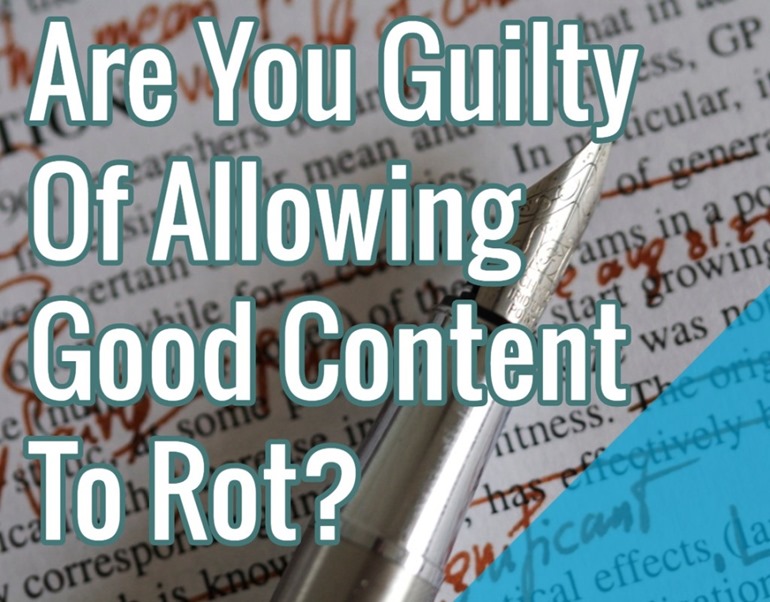
Updating old blog content is an interesting online marketing tactic. It doesn’t require a lot of hard work – unlike creating new content from scratch – and it brings a lot of benefits to the table.
The only catch is that you need to have content that can be updated, and that your blog already has steady traffic and a decent email newsletter list. Otherwise, while you’re still free to apply this method, you might want to focus on other types of growth for your blog, such as increasing traffic and adding to your newsletter list by publishing new content. (See also: 20 Tactics to Drive 200,000 More Monthly Visitors To Your Blog)
So, the main purposes of updating older content is to increase existing traffic to your blog, to get a piece of content higher in rankings, or use tweaks in order to improve conversions.
Why You Should Update Content
- Improved user experience – readers find content easier with new, better targeted keywords, and they stumble upon relevant content that helps them.
- Greater odds at higher rankings – you can target new keywords, besides inserting new information. Based on the keyword research you do, you can change or add to the keywords each piece is ranking for. It’s worth revisiting older articles and applying topical optimization.
- More quality leads – by optimizing the content on your pages, you increase your changes at targeting quality leads whether it’s by changing the CTA, or matching the post with an even better offer you have created since then.
- Republished content shows up on your blog’s homepage, so for your readers, it’s like you’ve added new content that will attract and keep them on your blog.
- Freshness factor – adding a new date, new content, and hitting republish will make Google’s algorithm reconsider your piece and increase your chances of ranking higher.
- You can attract new traffic, new inbound links and social shares thanks to promoting the re-published article.
What To Update
It should be content you can add new information to, which you can improve in some way and bring up to date. And the improvement should be significant enough to be worthy of the re-publish button and new promotion across your channels.
When you want to update an article in order to boost its rankings, you may want to focus on content that is at least 12 months old.
You want to deal with content that has stabilized rankings. Ideally, you will be updating content that still receives a lot of traffic, that converts well, or both. Or content that has the potential for more traffic and/or conversions if you just give it a little love. Perhaps some new keyword targeting to better match searcher intent. And for this to happen the right way, you need to be certain of the metrics you’re looking at for each piece you choose.
It’s also worth mentioning that the articles you put the effort into improving should have the potential to rank on the first page – in case they don’t. So you’ll mostly be looking at articles that rank on the second or third page, and which you can confidently feel you can send to the first page, or even the first position.
Here are some factors to consider:
- The article has plenty inbound links, or the potential for more
- It has a lot of traffic, but does not convert
- It converts, but doesn’t have enough traffic
- It received (and still might) a lot of social shares
- The subject is still relevant, or perhaps re-trending
How To Update Content
You can apply these methods to your blog articles or eBooks. It’s usually done for blog articles because the aim of updating is to improve traffic, search rankings, visibility, and conversions.
But the philosophy behind this is that you want your readers to find you in tip-top shape all the time, so you could apply it to other forms of content as well. It just won’t be as easy as improving a blog article. In the case of video, for instance, you can’t just add a few more minutes to a clip you made a year ago. But… you can build off it. You probably still have the script for the video, and you can start with that by bringing the information in it up to date, rewrite certain parts, and re-shoot the video.
Articles that go through significant changes and/or receive a new publish date, it’s worth considering adding an editor’s note mentioning the post has been updated and, high level, what has been updated. This is especially necessary for posts that have received comments, so as to eliminate confusion for new readers who might notice the different date on the comments.
1. Edit, Rewrite, Add
First, look at the content quality in the article you’re tweaking. Is it up to date? Is it comprehensive enough? Could you add more relevant and up to date statistics and information? Could you point to better resources, give better references and quotes?
- Add new information to bring the article up to date with latest information
- Expand a piece of evergreen content – such as adding information to broaden its scope, or target a wider audience, or target audiences by their location, sex, age, etc.
- Add new data and statistics to maintain accuracy and raise value
- Add new solutions to a problem the article solves
Make sure the article’s topic is well covered. At this point, you could also do a simple search on the keyword/s the article is ranking for and check out the other articles on the first SERP. Do they provide better coverage of the topic? Could you make yours better?
2. Keyword Targeting & Searcher Intent
Look to see whether the article’s keyword targeting is accurate. Is the searcher intent aligned? Are the other results similar? Use a keyword research tool and your analytics to determine whether there’s other keyword opportunities out there that would allow you to further optimize the piece. Think of topical optimization and figure out whether you can add similar terms that would make the article easier for the search engine to index and rank.
You can not only update the content, but change keyword strategy as well – find better terms, or if it’s been some time since the last update, or no update, optimize better for semantic search. Add those related cloud keywords that will make you rank better for the topic, and not just for a particular keyword.
Verify that the keywords you used are still the main ones used today. Maybe other terms have surfaced?
3. Images
If there are no images, consider adding some to break the blocks of text. There are many benefits to adding images to your articles. Posts with images get 650% increased engagement, as documented by this WebDAM infographic – in there, you’ll find even more stats that highlight the increasing importance of the visual component. The right kind of images and screenshots will also improve the piece’s credibility and trustworthiness.
If images are already present, perhaps you can replace them with better ones, or add more to match the content in its new form. Consider adding screenshots, and any other kind of images that will help get the piece’s point across.
Update screenshots of websites and tools with current ones: you don’t want to feature screenshots from 10 years ago…
4. Outbound & Internal Links
Are the outbound links and references you’ve added still valid? Look for broken links, check to see whether the resources you’re pointing to are still useful, and replace them as needed.
What about internal links? Is there a way to improve the internal link profile of this article? Perhaps you can now link to other articles in your blog. You don’t want to be overdoing it, so if there’s better pages you can now point to, consider removing some of the older ones.
Then, use a backlink tool to see what websites and webpages have linked towards your article. Are they quality, relevant pages? If the piece will end up with a great improvement, consider doing some more outreach to high authority sites to pitch for a link. 
If the update is substantial enough, reach out to those who have linked and shared already and let them know the updated version is out.
5. Conversion Optimization
Match your offers and blog posts better, so you increase the chances that searchers find what they needed when they reached your blog post. This is a keyword-based conversion rate optimization method that you’ll apply on-page. Here, you may have to test different types of adding CTAs on your posts – some prefer simple text CTAs in the article, others have seen higher conversions by adding CTA boxes at the end of a piece.
Using blog analytics, see which keywords lead the best traffic to your most viewed posts, and improve CTA on those posts using the keyword phrases that attract the most traffic. This article by Hubspot explains how to map lead nurturing content to match the buyer’s cycle.
You can also do this on landing pages by updating and improving offers on them, and matching keywords in your copy with queries and searcher intent. So you don’t just update the content behind them, but the copy on the pages as well, see CTAs above.
Final Steps
Add the updated content to your editorial schedule. Decide if you want to update (leave the date as is) or republish (new date). If you republish, hit republish on that day. If you schedule the content to go live on the republish day it will be hidden from public sight in your CMS’ content queue!
Add content promotion to your schedule as well, just as you do with new content: include in your email newsletter, and promote it across social media.
Hand-Picked Related Articles:
- 5 Effective Strategies for Recycling Old Content
- 10 Reasons To Edit Your Published Blog Posts
- The Simple, Effective Formula That Guarantees You Write Everything Better
* Adapted lead image: ![]()
![]() Some rights reserved by Nic’s events
Some rights reserved by Nic’s events
Are You Guilty Of Allowing Good Content To Rot?
The post Are You Guilty Of Allowing Good Content To Rot? appeared first on Search Engine People Blog.
Search Engine People Blog(44)
Report Post






